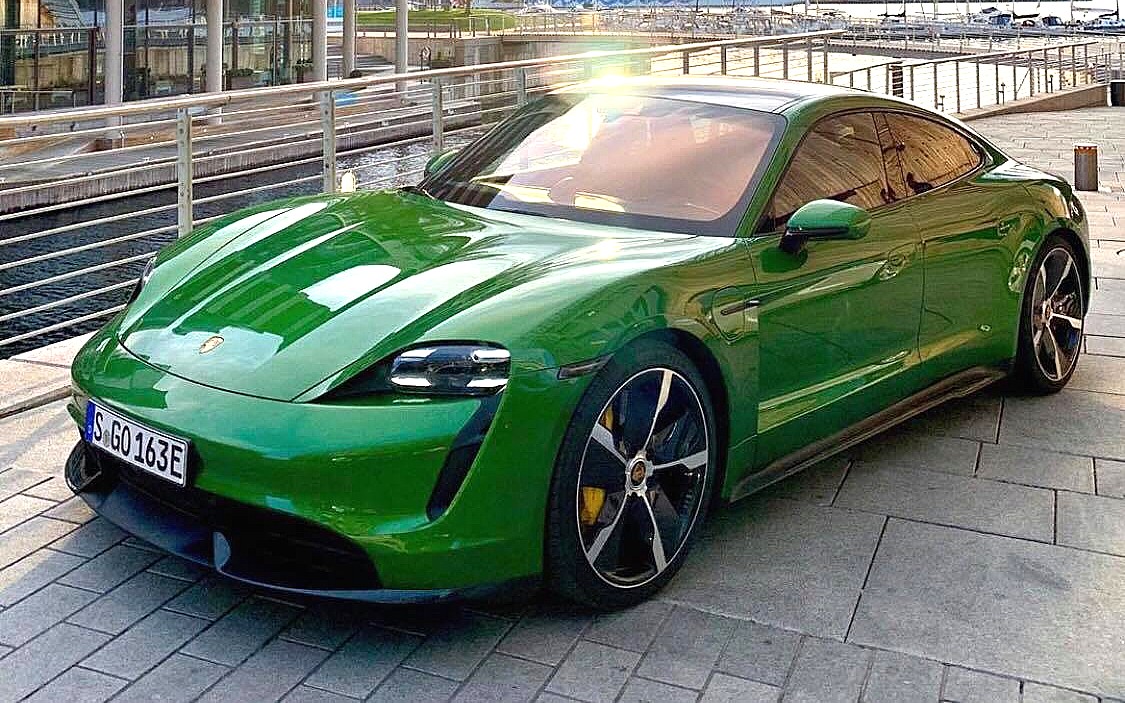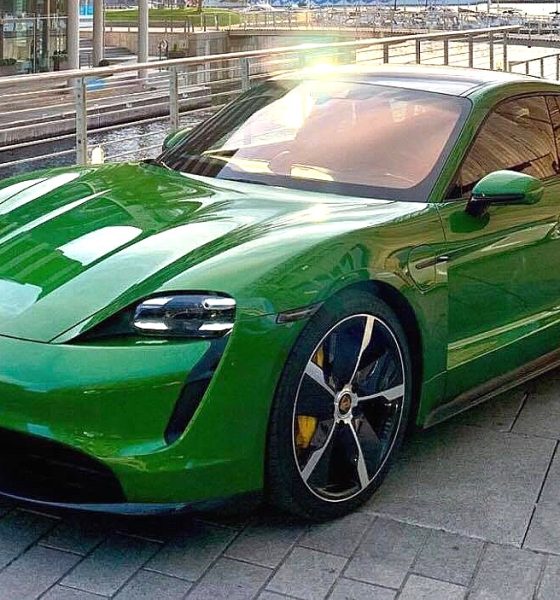

News
Porsche Taycan finds warm welcome among veteran Tesla owners–this is a good thing
The Porsche Taycan may be seeing some delays in its production schedule, but the all-electric vehicle from Stuttgart’s premier sports car maker continues to attract a lot of interest nonetheless. And if a recent statement from Klaus Zellmer, president and CEO of Porsche Cars North America, is any indication, it appears that the Taycan is starting to attract veteran EV adopters, particularly those who are existing Tesla owners.
In a statement to CNBC during the LA Auto Show, Zellmer stated that out of “thousands” of potential US customers who have shown a “sincere interest” in the Taycan, Tesla owners are among the largest groups among non-Porsche owners. The Porsche North America CEO stated that this was a surprise, but it is a very pleasant one considering the loyalty of Tesla’s customer base.
“They currently drive a Tesla, they’re open to experiencing something new now. We’re very happy about that. We were actually surprised right from the get-go to see Tesla be so much in the foreground as a potential source of business,” Zellmer said.
This statement has been interpreted by Tesla critics as a sign that the Taycan is starting to eat into the Silicon Valley-based electric car maker’s customer base. While this may be the case in some cases, there is a good chance that there is a completely different reason behind Tesla owners’ interest in the Taycan. A lot of it has to do with the price of the Taycan itself, as well as its target demographic.
It should be noted that before the Model 3, Tesla exclusively produced premium electric cars that competed in the luxury market. This means that before the Model 3, Tesla’s customers were comprised mostly of upper-tier households that can afford the premium price commanded by the flagship Model S sedan and Model X SUV. This particular demographic also tends to be fully capable of keeping two or more vehicles in their garages.
Considering that the most affordable Taycan, the Taycan 4S, is more expensive than the top-tier Model S Performance, there is a good chance that Porsche’s all-electric sports car is attracting the interest of customers who can afford a thoroughbred sports EV and a Tesla if needed. This is especially true considering that Tesla is focusing most of its efforts in the Model 3, a vehicle that is roughly half the price of the cheapest Taycan, and about a third of the price of the mid-tier Taycan Turbo.
In conclusion, the interest in the Taycan coming from existing Tesla owners bodes well for the electric car movement as a whole. In Porsche’s part, this means that its first foray into the modern all-electric car is seeing interest from some of the most experienced EV owners in the market. This also bodes well for Tesla, as it shows that the company has conditioned its customers to explore other options, but only those that are also all-electric. This is very encouraging, as Tesla is now attempting to disrupt the mid-tier market with the Model 3, a vehicle that is accessible to far more customers than the Model S and X.
As for the bearish thesis that the Porsche Taycan is “stealing” sales from Tesla, this might not hold water at all. Experienced EV buyers, especially those that have owned Teslas in the past, are aware that the Taycan is priced above the Model S despite having far less range and less driver-assist systems like Autopilot. Thus, these customers are likely not “leaving” Tesla because Porsche’s EV is “far superior.” Instead, they are likely purchasing the Taycan for what it truly excels at: a driving experience that echoes the best that Porsche can offer.

Elon Musk
Elon Musk’s X will start using a Tesla-like software update strategy
The initiative seems designed to accelerate updates to the social media platform, while maintaining maximum transparency.

Elon Musk’s social media platform X will adopt a Tesla-esque approach to software updates for its algorithm.
The initiative seems designed to accelerate updates to the social media platform, while maintaining maximum transparency.
X’s updates to its updates
As per Musk in a post on X, the social media company will be making a new algorithm to determine what organic and advertising posts are recommended to users. These updates would then be repeated every four weeks.
“We will make the new 𝕏 algorithm, including all code used to determine what organic and advertising posts are recommended to users, open source in 7 days. This will be repeated every 4 weeks, with comprehensive developer notes, to help you understand what changed,” Musk wrote in his post.
The initiative somewhat mirrors Tesla’s over-the-air update model, where vehicle software is regularly refined and pushed to users with detailed release notes. This should allow users to better understand the details of X’s every update and foster a healthy feedback loop for the social media platform.
xAI and X
X, formerly Twitter, has been acquired by Elon Musk’s artificial intelligence startup, xAI last year. Since then, xAI has seen a rapid rise in valuation. Following the company’s the company’s upsized $20 billion Series E funding round, estimates now suggest that xAI is worth tens about $230 to $235 billion. That’s several times larger than Tesla when Elon Musk received his controversial 2018 CEO Performance Award.
As per xAI, the Series E funding round attracted a diverse group of investors, including Valor Equity Partners, Stepstone Group, Fidelity Management & Research Company, Qatar Investment Authority, MGX, and Baron Capital Group, among others. Strategic partners NVIDIA and Cisco Investments also continued support for building the world’s largest GPU clusters.
News
Tesla FSD Supervised wins MotorTrend’s Best Driver Assistance Award
The decision marks a notable reversal for the publication from prior years, with judges citing major real-world improvements that pushed Tesla’s latest FSD software ahead of every competing ADAS system.

Tesla’s Full Self-Driving (Supervised) system has been named the best driver-assistance technology on the market, earning top honors at the 2026 MotorTrend Best Tech Awards.
The decision marks a notable reversal for the publication from prior years, with judges citing major real-world improvements that pushed Tesla’s latest FSD software ahead of every competing ADAS system. And it wasn’t even close.
MotorTrend reverses course
MotorTrend awarded Tesla FSD (Supervised) its 2026 Best Tech Driver Assistance title after extensive testing of the latest v14 software. The publication acknowledged that it had previously criticized earlier versions of FSD for erratic behavior and near-miss incidents, ultimately favoring rivals such as GM’s Super Cruise in earlier evaluations.
According to MotorTrend, the newest iteration of FSD resolved many of those shortcomings. Testers said v14 showed far smoother behavior in complex urban scenarios, including unprotected left turns, traffic circles, emergency vehicles, and dense city streets. While the system still requires constant driver supervision, judges concluded that no other advanced driver-assistance system currently matches its breadth of capability.
Unlike rival systems that rely on combinations of cameras, radar, lidar, and mapped highways, Tesla’s FSD operates using a camera-only approach and is capable of driving on city streets, rural roads, and freeways. MotorTrend stated that pure utility, the ability to handle nearly all road types, ultimately separated FSD from competitors like Ford BlueCruise, GM Super Cruise, and BMW’s Highway Assistant.
High cost and high capability
MotorTrend also addressed FSD’s pricing, which remains significantly higher than rival systems. Tesla currently charges $8,000 for a one-time purchase or $99 per month for a subscription, compared with far lower upfront and subscription costs from other automakers. The publication noted that the premium is justified given FSD’s unmatched scope and continuous software evolution.
Safety remained a central focus of the evaluation. While testers reported collision-free operation over thousands of miles, they noted ongoing concerns around FSD’s configurable driving modes, including options that allow aggressive driving and speeds beyond posted limits. MotorTrend emphasized that, like all Level 2 systems, FSD still depends on a fully attentive human driver at all times.
Despite those caveats, the publication concluded that Tesla’s rapid software progress fundamentally reshaped the competitive landscape. For drivers seeking the most capable hands-on driver-assistance system available today, MotorTrend concluded Tesla FSD (Supervised) now stands alone at the top.
News
Elon Musk’s Grokipedia surges to 5.6M articles, almost 79% of English Wikipedia
The explosive growth marks a major milestone for the AI-powered online encyclopedia, which was launched by Elon Musk’s xAI just months ago.

Elon Musk’s Grokipedia has grown to an impressive 5,615,201 articles as of today, closing in on 79% of the English Wikipedia’s current total of 7,119,376 articles.
The explosive growth marks a major milestone for the AI-powered online encyclopedia, which was launched by Elon Musk’s xAI just months ago. Needless to say, it would only be a matter of time before Grokipedia exceeds English Wikipedia in sheer volume.
Grokipedia’s rapid growth
xAI’s vision for Grokipedia emphasizes neutrality, while Grok’s reasoning capabilities allow for fast drafting and fact-checking. When Elon Musk announced the initiative in late September 2025, he noted that Grokipedia would be an improvement to Wikipedia because it would be designed to avoid bias.
At the time, Musk noted that Grokipedia “is a necessary step towards the xAI goal of understanding the Universe.”
Grokipedia was launched in late October, and while xAI was careful to list it only as Version 0.1 at the time, the online encyclopedia immediately earned praise. Wikipedia co-founder Larry Sanger highlighted the project’s innovative approach, noting how it leverages AI to fill knowledge gaps and enable rapid updates. Netizens also observed how Grokipedia tends to present articles in a more objective manner compared to Wikipedia, which is edited by humans.
Elon Musk’s ambitious plans
With 5,615,201 total articles, Grokipedia has now grown to almost 79% of English Wikipedia’s article base. This is incredibly quick, though Grokipedia remains text-only for now. xAI, for its part, has now updated the online encyclopedia’s iteration to v0.2.
Elon Musk has shared bold ideas for Grokipedia, including sending a record of the entire knowledge base to space as part of xAI’s mission to preserve and expand human understanding. At some point, Musk stated that Grokipedia will be renamed to Encyclopedia Galactica, and it will be sent to the cosmos.
“When Grokipedia is good enough (long way to go), we will change the name to Encyclopedia Galactica. It will be an open source distillation of all knowledge, including audio, images and video. Join xAI to help build the sci-fi version of the Library of Alexandria!” Musk wrote, adding in a later post that “Copies will be etched in stone and sent to the Moon, Mars and beyond. This time, it will not be lost.”








